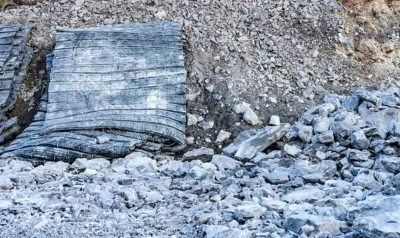Photo: Blast mats are made up of old old tires sandwiched together to form a thick blanket. The mat is placed on top of the explosive charge so that when the explosion is triggered, the fly rock and other debris is captured and held under the mat.
Purpose of Survey
Pre-blast surveys are conducted to alleviate property owner concerns in the vicinity of blasting activity. The survey acts as a baseline for assessment and evaluation of any claims against the contractor after blasting is completed. Surveys are intended to provide a representative sampling of pre-existing conditions that are present in every building. It is not an exhaustive report detailing every minute crack and deformity in the building.
Blasting Contractor’s Responsibility
The blasting contractor is responsible for the pre-blast survey. However, the pre-blast survey is performed by an independent inspection firm, to ensure impartiality. Municipalities typically require that a pre-blast survey be prepared for all buildings, utilities, structures, water wells, and facilities likely to be affected by the blast and those within 75 m of the location where explosives are to be used.
The blasting contractor shall include an explanatory letter to the owner or occupant with a formal request for permission to enter onto the property to conduct the pre-blast survey. The survey must be carried out at least 14 days before the permitted blasting.
Survey Format
The pre‐blast survey shall include the following:
- A project description and details of the blasting;
- The time, date and location of the blasting;
- The blaster’s name and contact information;
- The Pre‐Blast Surveyor’s name and contact information;
- The approximate start and completion date for the Pre-Blast Survey;
- Identify all structures included in the Survey; and
- Identify all structures not included in the Survey, and the reason why not.
Scope of Inspection
The Pre-Blast Survey shall include the following information:
- Type of structure, type of construction and the date when built.
- Identify existing settlement and/or differential settlement
- Identify visible cracks in walls, floors, and ceilings, room-by-room.
- Identify other apparent structural and cosmetic damage.
- Defects shall be described, including dimensions, where possible.
- Record defects by digital photos or digital video. Label with location and date stamp.
Survey Format, Wording and Photos
Pre-blast surveys shall list all defects identified during the survey. A generalized statement that is used to infer that a type of identified defect is common to a structure or room or wall, etc. is not acceptable unless that statement is accompanied with drawings, sketches or other documentation to adequately identify all those defects. Surveys standards are typically as follows.
- Interior rooms that have no defects identified must include a statement “room was completely inspected” or “no defects observed”.
- Any special situations or special structural conditions observed that may be affected by blasting should be noted in the survey.
- A description of the defect is required for all defects observed. Written documentation shall be supplemented in the survey by photos of the defect, or by drawing/sketching the defects.
- Photos or drawings shall be clearly tagged to the defect observed.
- Thumbnails will be accepted but high resolution photos shall be available.
- One overview photo shall be of the structure to clearly identify the entire structure as a reference photo for the survey.
- Photos of both the interior and exterior that are taken to document the current condition with no defects observed should be labeled “overview of …” for that photo.
Report and Distribution
Each survey shall be limited to a single residence or property. Upon request, a copy of the survey shall be provided to the owner of that residence or property.
Post-Blast Analysis
The blasting contractor will have set up seismic instrumentation to record the blast parameters. Suffice it to say that there is a generally accepted criteria for what does and does not cause damage to nearby structures.
One of the most used parameters is called the ‘Z Curve’ and the peak particle velocity (PPV) values. If the blast was well within the limits of the above curve, then it is unlikely that any property owner post-blast complaint will have merit with the contractor or insurance adjuster.
However, there may indeed be changes to the structure that were not there before. For example, after the blasting, settlement is observed around an outdoor pool. If the pool was installed after the house construction, then it may be traced back to poor soil or engineered fill compaction practice at the time of the pool installation. The blasting may have exacerbated its settlement, but was not the root cause.

